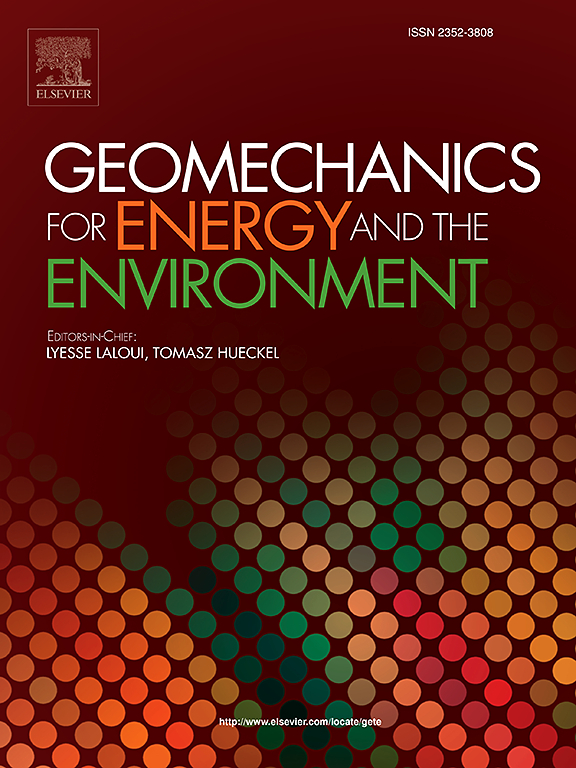The effect of climate change on the behaviour of thermo-active diaphragm walls
IF 3.7
2区 工程技术
Q3 ENERGY & FUELS
引用次数: 0
Abstract
Energy geo-structures are becoming more common as a renewable energy solution which utilises shallow geothermal energy to provide heating and cooling to buildings and civil infrastructure projects. Previous studies have shown that diaphragm walls subjected to combined thermo-mechanical loading show overall increases in lateral displacements, bending moments, shear forces, axial forces, and settlements on the retained side with thermal cycles. This study uses a variation of a validated numerical model to predict the behaviour of thermo-active diaphragm walls in the longer-term including accounting for the influence of climate change under contrasting RCP2.6 and RCP8.5 scenarios. This numerical model also assesses the impact of different modelling assumptions on the model output by comparing a simplified (isothermal boundary condition) model with a more complex model where atmospheric temperatures affecting ground temperatures are included, to inform the interpretation of physical model test data which typically use isothermal (simplified) boundary conditions. The results from this study show increases in lateral displacement, maximum bending moments, positive and negative shear forces and axial forces (compressive and tensile). Significantly, the RCP2.6 model shows that these increases begin to stabilise over the 50-year period modelled, while under RCP8.5, values continue to increase linearly at the end of the modelling period. The study also demonstrates the importance of capturing realistic model boundary conditions in long term studies. The more simplified model underestimates lateral displacements and internal stresses. The underestimation of lateral displacements is significant as this is the main driver of settlements on the retained side of the wall and has been identified as one of the most critical factors affecting long term performance of thermo-active embedded retaining walls.
气候变化对热活动连续墙性能的影响
能源土工结构作为一种可再生能源解决方案正变得越来越普遍,它利用浅层地热能为建筑物和民用基础设施项目提供供暖和制冷。先前的研究表明,连续墙在热-机械联合荷载作用下,随着热循环,横向位移、弯矩、剪力、轴向力和保留侧沉降量总体增加。本研究使用一种经过验证的数值模型的变化来预测热活动连续墙的长期行为,包括在对比RCP2.6和RCP8.5情景下考虑气候变化的影响。该数值模型还通过比较简化(等温边界条件)模型与更复杂的模型(其中包括影响地温的大气温度)来评估不同建模假设对模型输出的影响,从而为通常使用等温(简化)边界条件的物理模型测试数据的解释提供信息。本研究结果表明,横向位移、最大弯矩、正、负剪力和轴向力(压缩和拉伸)均有所增加。值得注意的是,RCP2.6模式显示,这些增加在模拟的50年期间开始趋于稳定,而在RCP8.5模式下,数值在模拟期结束时继续线性增加。该研究还证明了在长期研究中捕获现实模型边界条件的重要性。更简化的模型低估了横向位移和内应力。侧向位移的低估很重要,因为这是墙体保留侧沉降的主要驱动因素,并且已被确定为影响热活性嵌入式挡土墙长期性能的最关键因素之一。
本文章由计算机程序翻译,如有差异,请以英文原文为准。
求助全文
约1分钟内获得全文
求助全文
来源期刊

Geomechanics for Energy and the Environment
Earth and Planetary Sciences-Geotechnical Engineering and Engineering Geology
CiteScore
5.90
自引率
11.80%
发文量
87
期刊介绍:
The aim of the Journal is to publish research results of the highest quality and of lasting importance on the subject of geomechanics, with the focus on applications to geological energy production and storage, and the interaction of soils and rocks with the natural and engineered environment. Special attention is given to concepts and developments of new energy geotechnologies that comprise intrinsic mechanisms protecting the environment against a potential engineering induced damage, hence warranting sustainable usage of energy resources.
The scope of the journal is broad, including fundamental concepts in geomechanics and mechanics of porous media, the experiments and analysis of novel phenomena and applications. Of special interest are issues resulting from coupling of particular physics, chemistry and biology of external forcings, as well as of pore fluid/gas and minerals to the solid mechanics of the medium skeleton and pore fluid mechanics. The multi-scale and inter-scale interactions between the phenomena and the behavior representations are also of particular interest. Contributions to general theoretical approach to these issues, but of potential reference to geomechanics in its context of energy and the environment are also most welcome.
 求助内容:
求助内容: 应助结果提醒方式:
应助结果提醒方式:


